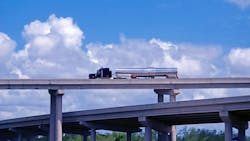Gaskins: How can fleets control insurance premium costs in the face of nuclear verdicts?
Those in charge of fleet operations, like those in charge of any business, are under constant pressure to reduce costs, optimize efficiency, and improve profitability. But for fleet operators, many of these pressures are out of their control. Equipment pricing continues to rise, fuel prices are volatile, and labor costs are increasing. This is on top of labor shortages fleets have long endured.
And then there’s the problem of fleet insurance premiums. Last year, the U.S. Chamber of Commerce Institute for Legal Reform published research on the problems of excessive trucking litigation. These nuclear verdicts, with awards of $10 million or more, are unsustainable, especially for smaller fleets with 10 or fewer trucks. And it’s patently unfair. As the research notes, “The average verdict increased by 867% between 2010 and 2018, even though trucking accidents per mile traveled decreased from 2000 to 2020. In other words, trucking is getting safer, but verdicts are getting bigger.”
Premiums reflect these larger verdicts
The rising number of lawsuits and excessive rewards is causing insurance premiums to rise. A 2023 article from Reliance Partners, an insurance agency specializing in the transportation and logistics industry, noted research by the American Transportation Research Institute that stated, “per-mile truck insurance premiums for small carriers saw a significant uptick, surging from 10.2 cents in 2021 to 13.6 cents in 2022.” The research also found that larger carriers, though still spending a huge amount on insurance, got a break because, according to ATRI, these “larger carriers experienced a decrease in premiums, dropping from 8.2 cents in 2021 to 7.2 cents in 2022.”
Remember, fleets are operating on very thin margins. An increase in insurance premiums will have to be paid for in other areas, negatively impacting the ability to grow the business. There are certainly steps that fleets can take to mitigate the chance of facing a lawsuit, specifically in the area of promoting safety.
Equipping all trucks with advanced driver assistance systems, including collision mitigation systems and lane departure warnings is a major step in the direction of safety. This should be backed up by spec’ing safety items throughout the fleet and adhering to strict preventive and predictive maintenance schedules. The importance of ongoing driver training cannot be overstated.
See also: How carriers can best manage insurance costs and risks in 2024
Safety alone isn’t enough to control insurance premium prices
Being safety-oriented is not enough. As everyone knows, your premiums (personal and business) are tied to the overall market. Certainly, if you have numerous accidents, your premiums will go up more than others. However, even though larger fleets saw that small drop in premiums in 2022, insurance costs continue to rise.
One possibility to control costs is to set up a self-insurance pool, where a number of different fleets would come together, creating an association that, like traditional insurance, would provide risk coverage and similar insurance services to the fleets within the association. Every fleet would contribute membership fees to the pool. The funds within that pool would then be used to provide liability protection. It’s important to note that companies have been operating this way for years when it comes to health insurance for their employees.
Controlling costs overall is essential for the financial health of fleets. The above may not be the ultimate cure, but they are steps in the right direction
About the Author

Patrick Gaskins
Senior vice president, Fleet Solutions
Pat Gaskins is the senior vice president of Corcentric Fleet Solutions, where he leads both the sales and operations teams for the company’s fleet offerings. He has over 30 years of experience as a financial services professional in the transportation industry and manages partnerships with over 160 manufacturers, helping over 2,000 of the country’s largest fleets manage all aspects of their fleet operations and fleet-related spend.
